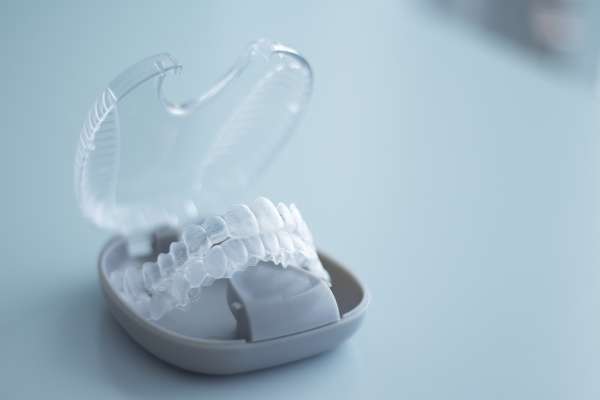Clear Aligners are an Alternative to Traditional Braces

Clear aligners offer a great alternative to traditional braces. Generations of people grew up wearing traditional metal braces to straighten their teeth. Traditional braces, though efficient and effective, make some people feel self-conscious. They also need many follow-up visits throughout the course of the therapy.
What are clear aligners
Clear aligners are custom-fit, custom-made mouthpieces that fit tightly over the teeth. Clear aligners are made from durable plastic or acrylic material. Clear aligners use gradual force to guide teeth into the proper position. A dentist or orthodontist will decide if a patient needs corrective orthodontics. They will outline a treatment plan describing how best to correct the prevalent issues.
How do they work?
Patients will be custom-fitted for several different mouthpieces. Each device is designed to make gradual corrections to the teeth over the course of the planned treatment period. Patients receive a new fitted mouthpiece every few weeks. Each mouthpiece has a slightly different shape to continue guiding teeth into the proper position. Orthodontists recommend wearing the aligner for 22 hours of each day. Patients can remove the clear aligners to clean them or to eat. This makes it easier to brush and floss the teeth as well.
How do they differ from traditional braces?
Traditional braces involve several different parts. To install them, the orthodontist attaches a small dental bracket to the front or back of each tooth. After that, the dentist will fit them with orthodontic bands, spacers, archwires, ties, a buccal tube, rubber bands and springs. Clear aligners are just a single piece per jawline. Patients remove them for eating, brushing and flossing so they won't be a bother. Clear aligners are exactly as their name suggests — clear or invisible, whereas traditional braces are not.
Are clear aligners for everyone?
Like most things, clear aligners are not a one-size-fits-all solution to dental problems. As stated on WebMD, because clear aligners are a custom-built tight fit, they are best for adults or teens. Elementary school-age children need special consideration as they are still growing and developing.
Who does well with clear aligners?
Patients with slightly crowded teeth or other spacing issues have the most success with clear aligners. Dental patients with severe crowding or spacing issues such as severe underbites, overbites or even crossbites, will probably need another treatment option.
Clear aligners vs. traditional braces
Braces and aligners both produce straighter teeth. Each therapy has unique pros and cons. Traditional braces, for instance, allow for fine-tuning in straightening teeth. Clear aligners are all created at the outset of the therapy and not adjusted during the process. Traditional braces are in place for the duration of the treatment period. Clear aligners can be removed and run the risk of being misplaced. Traditional braces complicate oral hygiene practices. Aligners provide a better oral health option because of their ability to be removed for regular cleaning. According to WebMD, braces often cause damage to the inside of the cheeks and gumline. Plastic or acrylic clear aligners avoid injury to the soft tissues inside the mouth. Aligners also help prevent patients from grinding their teeth. When deciding the best way to straighten teeth, be sure to discuss these issues with a dentist. They will patients make the best choice.
Learn more about clear aligners
Clear aligners are a great option for any patient looking for a straighter smile. Clear aligners are low maintenance. If you want a straighter, more confident smile, talk to your dentist today to see if clear aligners are right for you.
Request an appointment here: https://www.texasstarsmiles.com or call Texas Star Smiles & FastBraces at (254) 237-1342 for an appointment in our Killeen office.
Check out what others are saying about our services on Yelp: Read our Yelp reviews.
Related Posts
Invisalign® is a low-profile way to adjust the position of your teeth without needing to wear noticeable brackets in your mouth. The trays are simple to use and gradually shift the teeth over time to improve oral health and the aesthetics of your smile. The Invisalign process only takes a few steps from start to…
Invisalign® is a teeth straightening treatment that uses a series of clear aligner trays. While Invisalign can complete the straightening process faster than other options, proper maintenance of these trays is essential to an effective, comfortable treatment. The good news is that proper maintenance is easy for patients to complete regularly.While the dental provider will…
Orthodontics is a holistic way to improve the look and function of teeth. Orthodontic appliances exert steady and gradual pressure to improve the alignment of the teeth. Common appliances are braces, which do most of the heavy lifting for patients with moderate to severe malocclusions.Do you think that your child needs orthodontics? Keep going to…
While Invisalign® is an effective alternative to braces, it may not be the ideal treatment for everyone. The candidacy process happens in one appointment, involving X-rays, a physical examination, and a review of the patient's dental records. Here is a closer look at the factors we consider when choosing an ideal candidate.While we strongly advise…
